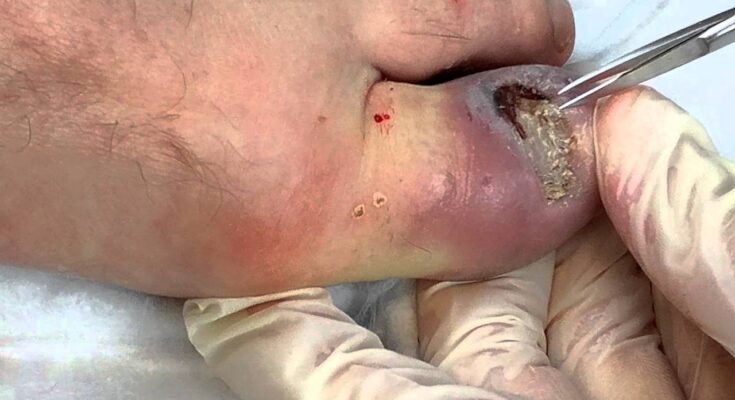A dystrophic ingrown toenail refers to a condition in which the toenail grows abnormally, often becoming thickened, deformed, and curved, and may start to grow into the surrounding skin. This can cause pain, swelling, redness, and sometimes infection. A dystrophic ingrown toenail can be more challenging to treat compared to a typical ingrown toenail due to the abnormal nail growth.
Causes of Dystrophic Ingrown Toenail:
- Trauma or injury: An injury to the toe can cause the nail to grow abnormally.
- Improper nail trimming: Cutting nails too short or rounding the edges may encourage the nail to grow into the skin.
- Tight or ill-fitting footwear: Shoes that put pressure on the toes can cause the nail to grow abnormally.
- Genetics: Some people are more predisposed to abnormal nail growth patterns.
- Fungal or bacterial infections: Infections can lead to nail thickening and deformation.
- Underlying conditions: Certain health conditions, like psoriasis or fungal infections, can contribute to nail changes.
Symptoms of a Dystrophic Ingrown Toenail:
- Pain and tenderness: Especially when pressure is applied to the toe or when wearing shoes.
- Swelling and redness: Around the edges of the toenail or the entire toe.
- Thickened or deformed toenail: The toenail may appear thicker, curved, or discolored.
- Infection: In severe cases, an ingrown toenail may become infected, resulting in pus or a foul odor.
Treatment Options:
- Conservative Treatment:
- Proper nail trimming: Carefully trim nails straight across and avoid cutting the corners too deeply. Avoid rounding the edges.
- Soaking the foot: Soak the foot in warm water with Epsom salts to reduce swelling and pain.
- Antibiotic ointment: If there’s an infection, applying an over-the-counter antibiotic ointment may help reduce infection risk.
- Padding or bandaging: Protect the affected toe with soft padding or a bandage to reduce pressure and irritation.
- Proper footwear: Wear shoes with enough room for your toes to avoid pressure on the affected toe.
- Medical Intervention:
- Partial nail removal: In cases where conservative measures don’t work, a podiatrist may perform a procedure to remove the portion of the toenail that’s ingrown.
- Matrixectomy: If the ingrown toenail is recurrent or severely dystrophic, a matrixectomy may be performed. This involves removing part of the nail matrix (the area where the nail grows) to prevent the nail from growing back abnormally.
- Antibiotics: If the ingrown toenail is infected, oral or topical antibiotics may be prescribed to treat the infection.
- Surgical Treatment:
- If the condition is chronic and doesn’t respond to other treatments, surgery to remove the entire nail or part of the nail matrix may be necessary to prevent recurrence.
Prevention:
- Trim nails properly: Always cut nails straight across and avoid rounding the edges.
- Wear comfortable shoes: Avoid tight or narrow shoes that can put pressure on your toes.
- Foot hygiene: Keep your feet clean and dry to prevent infections.
- Seek early treatment: If you notice early signs of an ingrown toenail, seek treatment before it becomes more severe.



